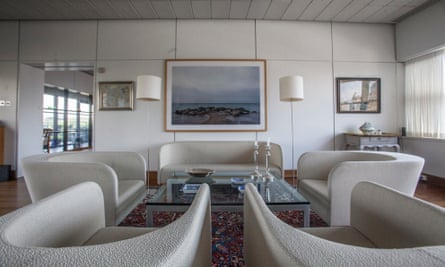There are portraits of José, Prince of Brazil, the unfortunately nicknamed Maria the Mad, and Catherine of Braganza, the woman who helped make Britain a nation of tea drinkers.
But why a drawing room in the grand London residence of the ambassador of Portugal houses an enormous portrait of a 17th-century English lady, Doddington Montagu, wife of the first Duke of Manchester, remains a mystery. Even to the Portuguese.
It could have been bought in the 1950s from an antiques store or auction or donated, ventured the embassy’s cultural officer, Catarina Coutinho Ferreira. “We don’t know the story of the painting or why it is here.”
Whatever the reason, the portrait attributed to the circle of John Closterman fits rather nicely in the room and will be one of many treasures on display this weekend as the National Trust organises behind-the-scenes tours of three European embassies.
They will take visitors into the French ambassador’s residence in Kensington Palace Gardens, or “Billionaire’s Row”, Arne Jacobsen’s 1970s Danish embassy on Sloane Street and the palatial home of the Portuguese ambassador in Belgrave Square.

Ivo Dawnay, the trust’s creative director, said they had realised Europe was going to be on everyone’s lips in 2016 and so decided on a programme of events that explored Britain’s relationship with Europe.
“We don’t take a view on in or out but we do want to highlight how, culturally, we are totally enmeshed – if not politically,” Dawnay said.
“Without taking any sides in the current controversy, we hope anyone who visits will at least acknowledge that Europe is a major part of the DNA of this country and has had a massive, positive contribution to our way of life.”
A good example of that is the Catherine Room on the ground floor of the Portuguese embassy, named after the Portuguese princess Catherine of Braganza, who became Queen of England when she married Charles II.
The room includes individual portraits of Catherine and Charles by Sir Peter Lely and a large tapestry from the 1950s depicting Catherine’s departure for England from Lisbon.
The story goes that the young princess arrived in Portsmouth on 13 May 1662 after a long, stormy crossing and, parched, asked for a cup of tea. Nobody really drank tea so she was instead offered a traditional English drink – a glass of ale. She sipped it, did not like it and went to bed ill.
But from that time on she insisted on drinking tea and it became highly fashionable – and the rest is history.
The marriage also had a profound impact in terms of the British empire. As part of the marriage dowry, Charles was given the seven islands of Bombay which he later rented to the East India Company.
In another room is a spectacular watercolour by Dame Paula Rego, the Portuguese-born artist, who donated the work when a previous ambassador visited her studio.
The embassy tours will take place this weekend on a first-come, first-served basis and are part of Heritage Open Days, England’s annual festival of history, which will see thousands of places open their doors.
In recent years the National Trust has organised tours of Croydon, the Big Brother house and Erno Goldfinger’s Balfron Tower. The tours are part of the trust’s attempt to shed its country house, cream tea and quick whizz round the shop reputation.
Dawnay said: “We feel that to reach new audiences we should realise that what we’re about is giving people access to interesting places, we don’t need to own them. We can work with partners and give people a good experience.”
As well as the embassy tours, the trust has launched Europe and Us in 99 Objects and on 17-18 September will hold a weekend of events at Mount Stewart, the late Viscount Castlereagh’s stately home in Northern Ireland, exploring the history and politics of British diplomacy with European powers.
